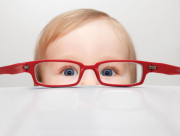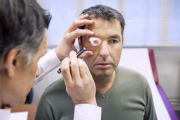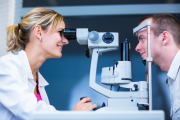Contents |
You Need a Eye Examination!
How to Prepare and What to Expect
Many people don’t recognize that a vision examination is essential as part of our periodic health checkups, assuming that while their vision seems normal, that all is well. In reality, this is really not a good indicator of when or why to have a comprehensive vision exam.
A comprehensive vision and eye health examination can alert your eyecare practitioner to the presence of not only ocular conditions, but systemic conditions such as diabetes, high blood pressure and heart disease.
Optometrists are considered to be primary health care providers, meaning that they are often the first physicians to see a patient with some of these serious health problems, before they see any other type of doctor.
Preparation
Before you arrive for your appointment, it is helpful to gather information about family eye health issues as well as general conditions, because many of them tend to run in families. You should include:
- Any family history of cataracts, glaucoma or macular degeneration; there is a genetic link to them.
- Your own general health condition, including such things as high blood pressure, high cholesterol, diabetes and heart disease; these can all have a profound effect on vision.
- Make a list (and carry it with you) of any and all medications you take, including the dosage. Include prescription, over-the-counter remedies and nutritional supplements.
- Be aware of any eye or vision issues you might have noticed since your last eye exam, and if your eyes have changed in any way. Include such things as your ability to read easily or * use a computer, driving vision in both daylight and after dark.
- Note if you have any symptoms like headaches or unusual sensitivity to light, or if your eyes get tired easily.
- Prepare a list of any questions that occur to you about your eyes and your vision.
When you come in for your appointment, bring your current eyewear, including reading glasses (even those you may have purchased over-the-counter). If you have a good-quality pair of dark sunglasses, bring them, too; if your optometrist uses dilating drops, your eyes will be more light-sensitive for a while afterwards
During your Eye Examination
Your vision examination will include a thorough history and review of your personal and family health issues and any vision-specific problems. He or she will also note medications and/or any nutritional supplements.
The optometrist will also ask about your work environment and will need to know such things as computer use, or drive a vehicle, for example, or if you may need to wear protective lenses.
Visual acuity, or sharpness of vision, is tested using a letter chart for both distance and close up for reading. There are several other tests, including these:
Pupillary Response is tested to see if both pupils react normally when a light is aimed at them; it is also important is to know if they expand properly when the light becomes dim.
Colour Vision will be tested by using one of several testing devices, to find out if you have normal colour perception; abnormal or unusual findings can indicate the need for further testing.
Normal Tracking and Jumping are important for the ability to read easily without losing your place. The movements should be smooth and accurate.
Peripheral Vision is usually tested using a visual field instrument, which will check for normal retinal sensitivity in the field of view. The instrument will find and document any areas where your side vision is unusual or lacking.
Refraction is the part of the testing process that determines if you would benefit from using eyeglasses to sharpen your vision or to decrease visual stress. These tests will help the optometrist determine if you have any refractive error. Refractive errors include nearsightedness, farsightedness, and astigmatism.
The refraction is done in two parts; one depends on your subjective ability to choose between one lens and another. The other part of the refraction is done using a retinascope by the doctor observing how light reflected from the back of the eye moves. With the retinascope, even infants can be tested to find out if they have an unexpected refractive error.
Testing will also be done to see if both eyes are relatively equal, if they focus properly and if they work together as they should.
Ocular Health Testing will check both the interior and exterior of the eye, using several instruments. The slit lamp, also known as a biomicroscope, will be used to observe the front part of the eye and its surrounding tissues, including the lids and eyelashes, the cornea, the white of the eye and its covering of transparent skin called the conjunctiva, the iris and the inner crystalline lens of the eye.
An ophthalmoscope is used to look directly into the eye, for a good view of the retina and the head of the optic nerve. The anatomy of these structures should not change once the eye finishes growing in the late teens, so any changes in their appearance could be significant. The tiny arteries and veins which nourish the retina and carry away waste products are also checked for changes or damage.
To get a good view of the structures inside the eye, most patients will have their pupils dilated, or enlarged, with eye drops that make the iris open to form a larger “window” to see through and evaluate the health of the eye. The blur and light sensitivity you may experience after your exam is the result of these drops, but the effects will wear off within an hour or two for most people. While the pupils are enlarged, the optometrist may decide to photograph the inside of your eyes so further document what they look like at the time of the exam. Even years later, a photograph will show exactly what the eye looked like on this day. The appearance of the eye is unique, even between identical twins; the structure of the blood vessels and the iris are much more individual than fingerprints, and have sometimes been used for identification purposes.
Your optometrist will have a way of gathering the information and recording it so the order in which this testing is done will vary, but your vision examination will contain these particular elements and others so that even years later, a different doctor can look at your chart (or at the computer it is stored on) and know exactly what the previous doctor did and what the findings were. At the end of your vision examination, the doctor will discuss the results and recommendations for treatment, if any.
When Should I Get a Vision Examination?
Children should have a comprehensive vision examination at six months, and again by the age of three, and each year thereafter, until they are adults at the age of twenty or so. This is because the eyes of a growing child can change quickly and a child does not know that other people don’t see just like he or she does. During school years, these changing eyes can interfere with the learning process and make it difficult for the child to read or learn quickly enough to keep up with others.
Between the ages of about twenty or twenty-one until early middle-age at around forty, a vision examination every two years is adequate for most people. The exception to this is if the person is continuing as a student into college or the university level. Students who are reading and studying can experience changes of refractive error such as an increase in the amount of nearsightedness (myopia). Current research indicates that need for clear vision and focusing at reading distance could be the underlying cause of myopic progression over time.
At about the age of forty, healthy adults usually begin to notice that they cannot read as easily as they once could; that is, they can’t sustain the focusing effort that gives clear vision at reading distance, which is about 16 inches for most people. This is a condition called presbyopia, and it causes people to need reading glasses or multifocal lenses. These lenses help keep the eyes focus. A vision exam is recommended every two years for patients in good health, but if there is any continuing health condition such as high blood pressure or diabetes, they should have their vision checked at least yearly or as often as indicated by either the optometrist or their primary care physician.
In surveys, people rate their vision as their most valuable sense, time after time. Vision and eye care is obviously an essential and a necessary part of overall health care. A comprehensive vision examination could be described as just about anything except “routine.”



